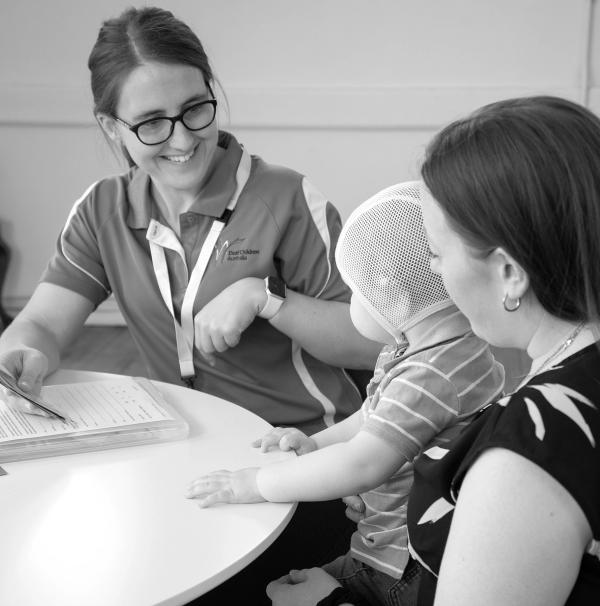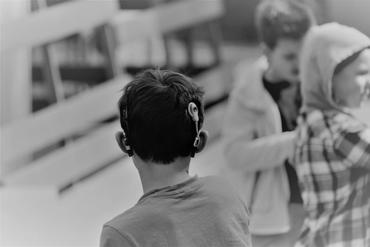All about cochlear implants
Cochlear implants might be an option if your child has permanent severe or profound hearing loss or has had limited success with hearing aids. Here’s some information to help you understand what they are, how they work, and whether your child might benefit from them.

What is a cochlear implant?
A cochlear implant is a type of implantable hearing device. They consist of two parts. One is surgically inserted (‘implanted’) into your child’s inner ear. The second is a sound processor your child wears like a hearing aid.
Unlike hearing aids, which simply amplify sound, cochlear implants mimic the body’s own hearing system. The goal of getting a cochlear implant is to help your child hear as well as possible to support development of listening and speaking skills.

How do they work?
A cochlear implant converts sound waves into electrical impulses that can be interpreted by the brain. Sound is captured by the microphone behind the ear, sent to the external sound processor, and converted into a digital signal.
This signal is passed along a lead to the transmitter coil, which sends radio waves across the skin to the implant. Next, the implant turns the signals into electrical impulses and sends them to the cochlea. This stimulates the cochlea’s hearing nerve (the auditory nerve), causing it to send a signal to the brain that is interpreted as sound.
Could my child benefit?
Your doctor, audiologist or early intervention service may suggest assessing your child for a cochlear implant if they have a permanent severe or profound hearing loss, or if progress with hearing aids has been limited. A cochlear implant isn’t suitable for all children who are deaf or hard of hearing, so it’s vital they are carefully assessed before an implant is recommended. This involves attending several appointments to build up a thorough picture of your child’s needs and options.
It’s important you understand potential benefits and risks so you can make an informed decision. Your team should clearly explain the process and answer your questions before you choose whether to go ahead. If your child is old enough, be sure to include them in your decision-making. Having a cochlear implant involves a long-term commitment, so you’ll need time to think about it.

One ear or both?
Understanding speech when there’s background noise is easier when listening with two ears (known as ‘binaural’ hearing), as is determining which direction sound is coming from. Most deaf and hard of hearing children will use hearing devices in both ears. Your cochlear implant team might recommend your child has two cochlear implants (known as ‘bilateral’ fitting), or one implant and one hearing aid (known as ‘bimodal’ fitting). Their advice will be based on your child’s hearing level, any medical or other considerations, and the pros and cons of both options.
How much does it cost?
Public funding is currently available for children needing implants in one or both ears.
What happens during the implant procedure?
Fitting a cochlear implant is a routine procedure. It is done by an ENT surgeon or cochlear implant surgeon and takes around one to three hours. Afterwards, your child will spend a few hours in recovery. Your healthcare team will explain how to look after your child at home following surgery.
Once your child has healed, the sound processor gets fitted. Your implant clinic team will explain all you need to know and do from there. You’ll have regular follow-ups to check how things are going and fine tune the sound processor.

Research shows that if children are born with a profound bilateral hearing loss, they achieve optimal spoken language outcomes if they get a cochlear implant before 12 months of age.
If English isn’t your first language, ask if you can have information translated and an interpreter available for meetings.
For some children, the best hearing outcomes will involve a cochlear implant in one ear and using a hearing aid on the other (known as ‘bimodal hearing’).
A cochlear implant isn’t a ‘cure’ for deafness. It’s important to support your child to feel positive about who they are and about their deafness.
Choosing to have a cochlear implant involves a lifetime commitment to caring for it and attending regular follow ups at the implant centre. Your family and health professionals will need to provide ongoing support for your child.

When you’re considering a cochlear implant, it can help to talk to families who’ve been through it. They can help you get a better sense of the process and a perspective on the pros and cons.
Implant surgery causes changes to the cochlea, which means your child probably won’t have the same level of hearing they had before surgery. This makes it unlikely your child could return to using a hearing aid in that ear.
There’s also a possibility the implant won’t work. This is one of the reasons why it’s so important to discuss the options with your child’s hearing professionals and carefully weigh up the potential risks and benefits.
If your child is being assessed for a cochlear implant, make sure they continue using their hearing aids during this period. This ensures their hearing pathways continue to be stimulated.



